Mattersburg appointed at the start of the season 2019/20 Franz Ponweiser as their new manager, but the first season as head coach in Austria’s top-flight was for the 44-years-old coach not that great. After the opening 22 games, Mattersburg have just 18 points and lost 14 matches. Furthermore, they just scored 26 goals , but probably the more astonishing fact is that they conceded 52 goals what means they conceded on average 2.36 goals per game.
Due to their poor performances in this season, they finished in the 11th place and only St. Pölten collected fewer points (17). However, when it comes to the xG against, Mattersburg have the second-highest value of all teams in the Austrian Bundesliga with 40.51 (for all 22 games).
In this tactical analysis in the form of a scout report, we look at the defensive tactics and issues of Mattersburg within the last few weeks between the winter break and the stop due to the coronavirus crisis.
System and short statistical breakdown
Ponweiser lines his team either up in a 3-4-3 or a 4-1-4-1 formation. During the first few games of the season, they mainly played with a 4-1-4-1 system while during the last games ahead of the corona crisis the 3-4-3 was clearly the preferred system. We will focus in this analysis mainly on the last few weeks and months in which they used the 3-4-3 system.
We will now have a quick look at their season stats to get a quick overview where there could possibly be some of the problems and then compare that to the actual aspects which we will find in the in-game analysis. Statistics don’t always tell you the whole truth, but they can sometimes point out at what you should take a more detailed look.
They concede 2.36 goals per game while their xG against is 1.84 which means that they conceded more goals as expected. However, they face 14.4 shots per game what is the second-highest value of the league what means that their opponents get quite easily and often into positions from where they can shoot.
They have on average 45.3% of the time possession of the ball what is an average value in the Austrian Bundesliga and shows us that they aren’t a team who only sit back deeper and wait for the opposition. Also, their average value for PPDA (passes per defensive action) which is a good indicator for the pressing intensity of a team is 8.84 while the league average is 8.86. This once more shows us that they also want to win the ball higher up the pitch as we will see in the following part of this tactical analysis in the form of a scout report.
As the last statistic, I would like to mention the number of defensive duels per 90 minutes. Mattersburg is per game in 59.27 defensive duels involved what is the second-lowest value of all teams in Austria’s top-flight what is a clear sign that they aren’t always able to win the ball as they don’t even get into the duel. We will come back to that a bit later in this scout report.
The high press
The topic of this tactical analysis are the defensive tactics and problems of Mattersburg in this season and they have bad values for their conceded goals and other defensive metrics too. Furthermore, after the opening 22 games of the Austrian Bundesliga, only one team have collected fewer points than the team of Ponweiser. When you just hear that, you usually would expect a team which mainly focus on defending in a low- or mid-block and trying to hurt the opponent on the break. However, Mattersburg use in almost every game also a high pressing and occasionally also a counter-pressing. Even though you definitely can see a lack of confidence in several moments what is just normal in such a situation, they still are brave and want to show their fans also an offensive and attractive football.
When they use a high press, they mainly try to force the opposition on one wing, create numerical equality or superiority there and keep it compact to win the ball as we can see in the example below in the match against Rapid Vienna. Marko Kvasina (in this situation the left-winger in the 3-4-3) uses a curved run to force Christopher Dibon to continue the play on Mattersburg’s right side.
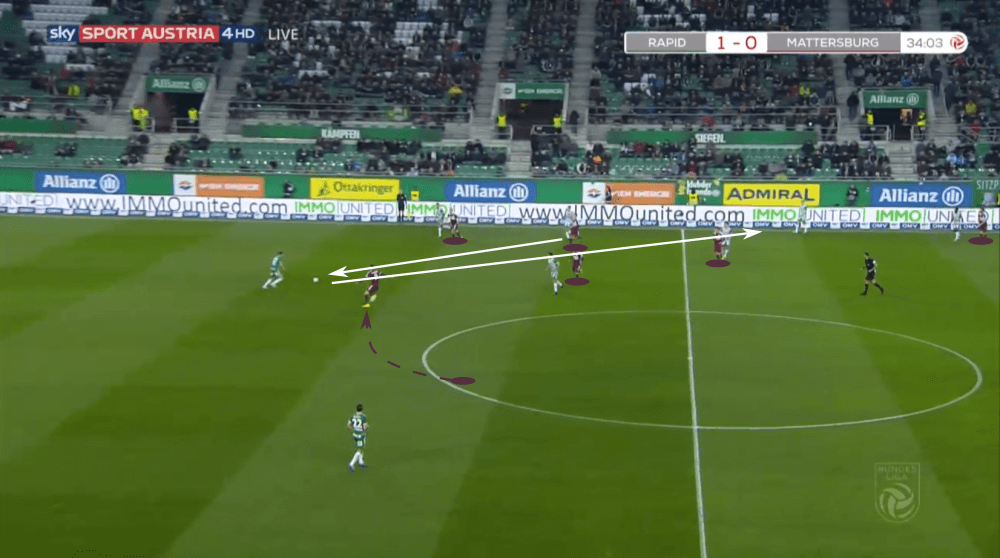
Of course, this is quite risky since they have on the other side almost no player and Rapid Vienna’s Filip Stojković (one of the very few players in the Austrian Bundesliga with appearances in the UEFA Champions League due to his time at Red Star Belgrade) has a lot of space. However, Kvasina times his run perfectly what gives Dibon no chance to switch the side and he has to play it back to the wing where Mattersburg can win the ball.
We can also sometimes see a pattern during the press in which the three forwards stay quite narrow to force the opposition to play the ball to the wide-area where then the wing-back puts pressure on the player who receives the ball. A perfect example of that can be seen in the shot below.
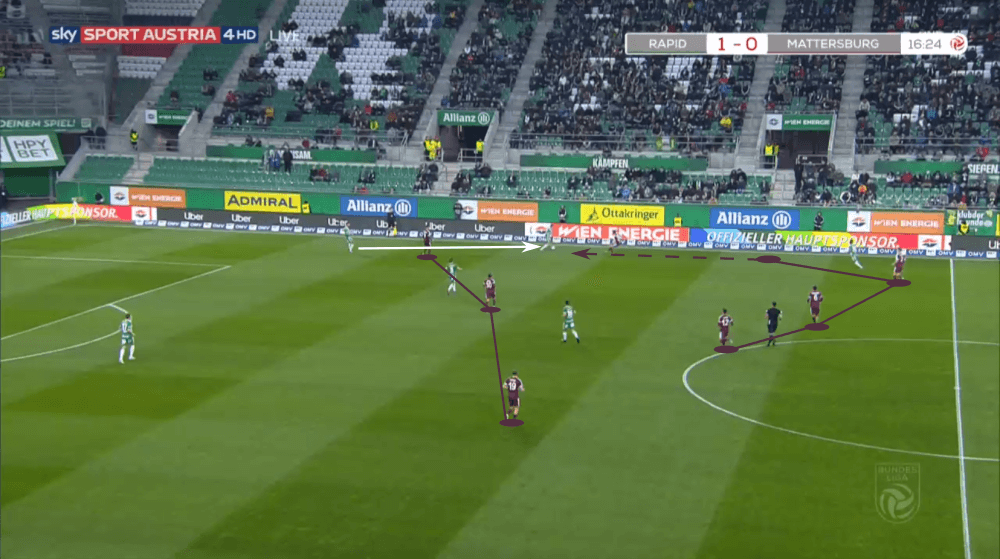
Anyways, even though their high pressing is often a joy to watch and it’s great to see a team which is mostly the underdog also putting pressure on the opposition higher up the pitch, we can often notice a lack of vertical compactness and that not all 10 player shift together forward to execute the pressing.
One of the most important rules of the pressing is that all outfield player must work together and follow the same plan and pattern respectively. I wouldn’t say that we can watch this regularly during Mattersburg’s press, but in some situations, these mistakes can also be seen, and this gives the opposition the chance to bypass the press. If they can also work on that, their high pressing will become even more effective.
Space between the lines and when the ball is played wide
Basically, before we take now a more detailed look at the defensive tactics of Mattersburg when they sit back deeper, I need to mention that they had to deal in this season with several injuries what lead to several changes and that means that you can’t always expect that everything works off perfectly. We need to keep that in mind, but still, there were some things which stood out and led to several goalscoring-chances and goals for the opposition.
From now on, we’ll focus on Mattersburg’s style of play whenever they sit back deeper, form a 5-2-3 and 5-4-1 formation respectively depending on the line of the two wingers. The two wing-backs rarely stay higher and mostly drop back on the level of the three centre-backs as we can see perfectly in the game against Altach.
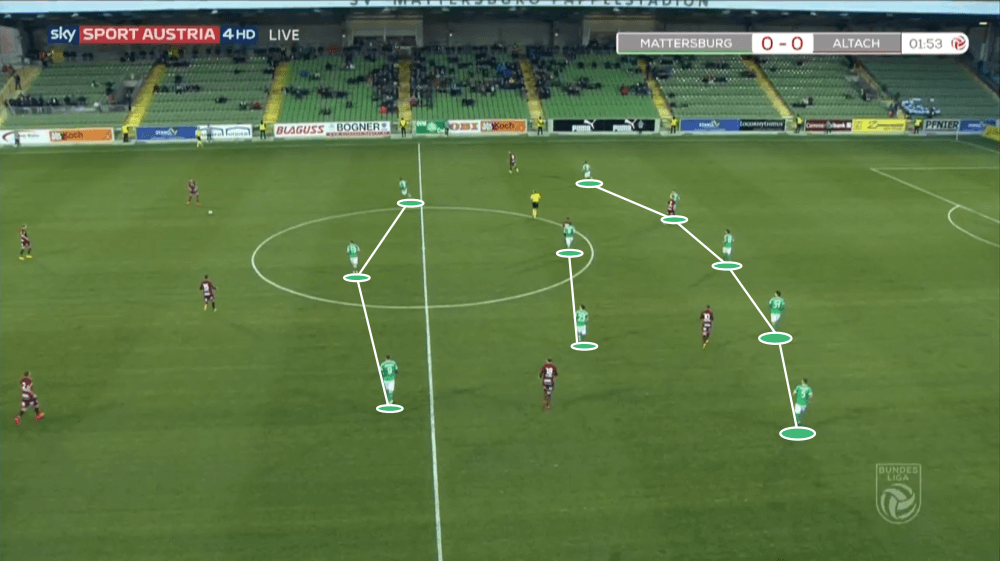
One interesting stat which stood out in the opening paragraph of this scout report is that they are on average just involved in 59.27 defensive duels. One main reason for that is that they defend quite man-orientated in the last line and often want to intercept passes and cut off all passing lanes instead of going into a defensive duel. This will get even more obvious when we look in the following and last part of this scout report at the back three.
Since they usually act quite man-orientated on the height of the back five, the two central midfielders often push forward and rely on the defenders to mark their opponents closely. However, this doesn’t always work off since the defenders are sometimes too wide away from their opponents what leads to a huge space between the lines. In the example below Altach’s wingers, Sidney Sam (former Bundesliga star at Schalke 04 and Leverkusen) and Emanuel Schreiner switched positions. So, the usual left-winger Schreiner was on the right side and slowly made his way into the centre while no single opponent tracked his run and due to that, he was completely free to receive a penetrating pass.
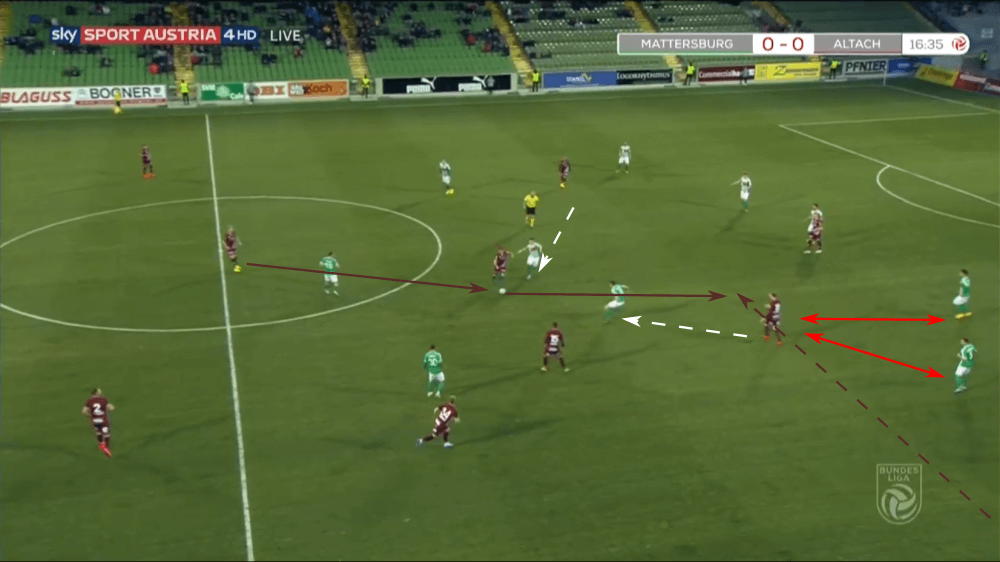
So, we now saw that there are sometimes problems in which the back five doesn’t push forward quickly enough to avoid giving away too much space in front of them.
Next, I want to discuss how they act when the ball gets played towards the wide areas as we can see below. In these situations, usually, the wing-back and the winger work together on the wing, while the centre-back of the according side also shifts a bit to the outside and the other two men of the back three and the opposing wing-back remain in the centre to defend the cross. This gets visible in the shot below.
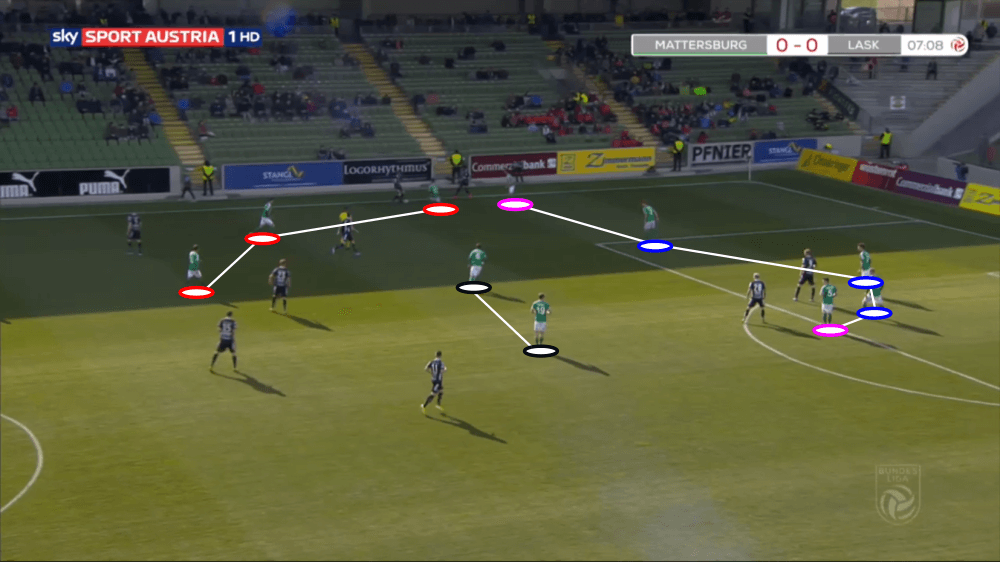
Anyways, we saw within the last weeks several times the same problem when the ball was played to the wide-areas, since then often the two central midfielders also joined their teammates in the penalty box to support them. However, in these moments, they were often all on one horizontal line what means that they occupied by far not all necessary space and additionally nobody tracked the runs of oppositional players who were positioned around the penalty spot. In the game against Rapid Vienna, exactly that led to a goal as Stefan Schwab started from a deeper position and nobody recognized his run since all the defenders were in one horizontal line. In the end, Schwab was able to score with a header as he was completely unmarked.
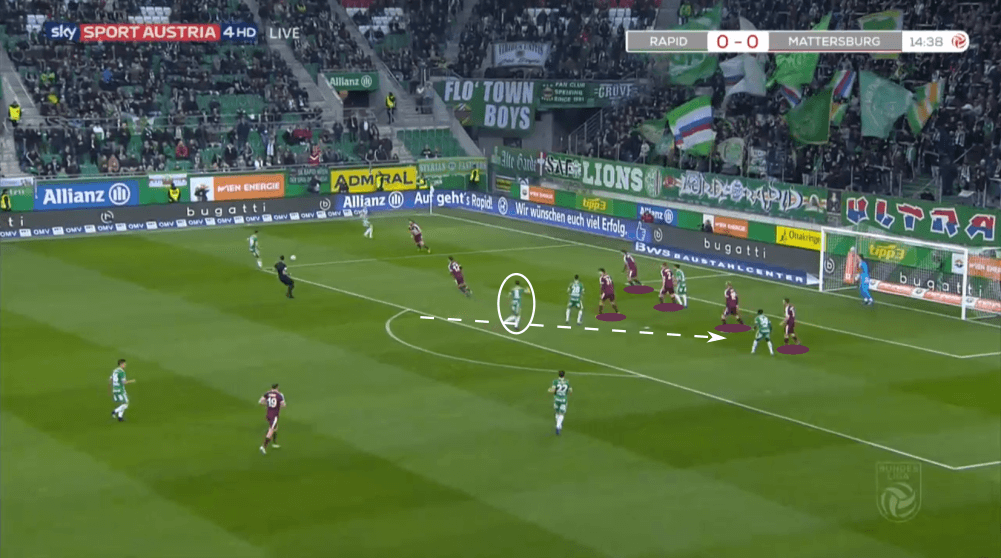
The behaviour of the back three
Even though Mattersburg used in this season in a lot of games a 4-1-4-1 formation, we focus in this scout report mainly on their defensive style of play after the winter break and in this period the 3-4-3 was their preferred system. Until now we talked about the high pressing which is often quite effective and saw that they have problems when it comes to defending in the space between the lines and when the ball gets played wide.
As the last part of this tactical analysis, I want to talk about the back three of Mattersburg which act extremely man-orientated, but we’ll look at that shorty. Before that, I want to mention that you saw several times that they had huge problems in the organization and communication. One aspect which perfectly tells us that is the offside line. There were several situations (like the one below) when not all three centre-backs were on the same height and the opposition exploited that with long through balls. The main reason for this classic problem is a lack of organisation and communication.
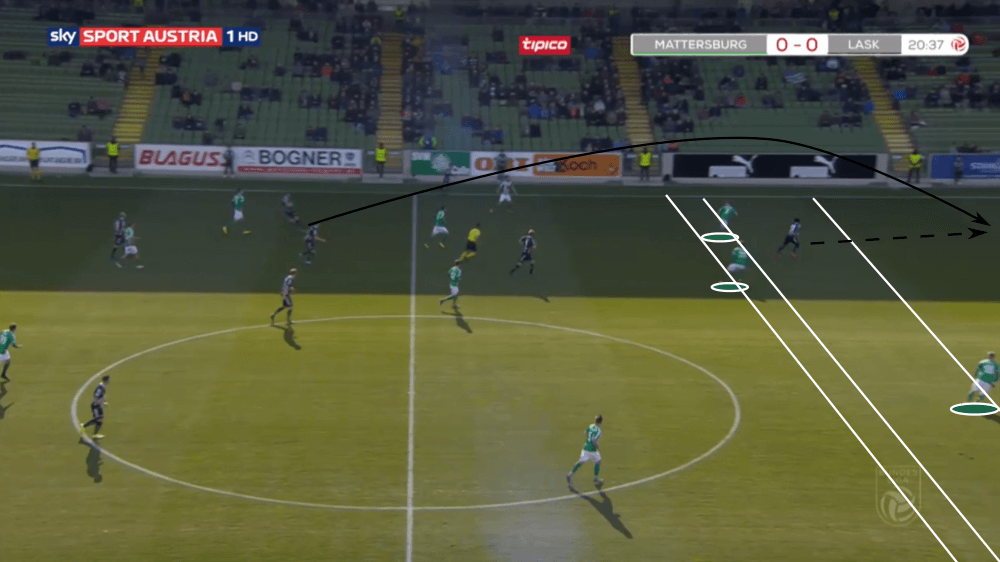
Next, we will look at the man-orientation which helped them massively in some situations, but in general, it is extremely risky. Their opponents tried several times to create space by using interesting movements which then drag especially the central defenders out of their position to then exploit the space which they usually would occupy
In the match against LASK Linz (who faced just a few days after that Manchester United in the UEL) for example, Dominik Frieser often dropped a bit deeper, lured out the left man of the back three (Lukas Rath) to then start into the space behind him.
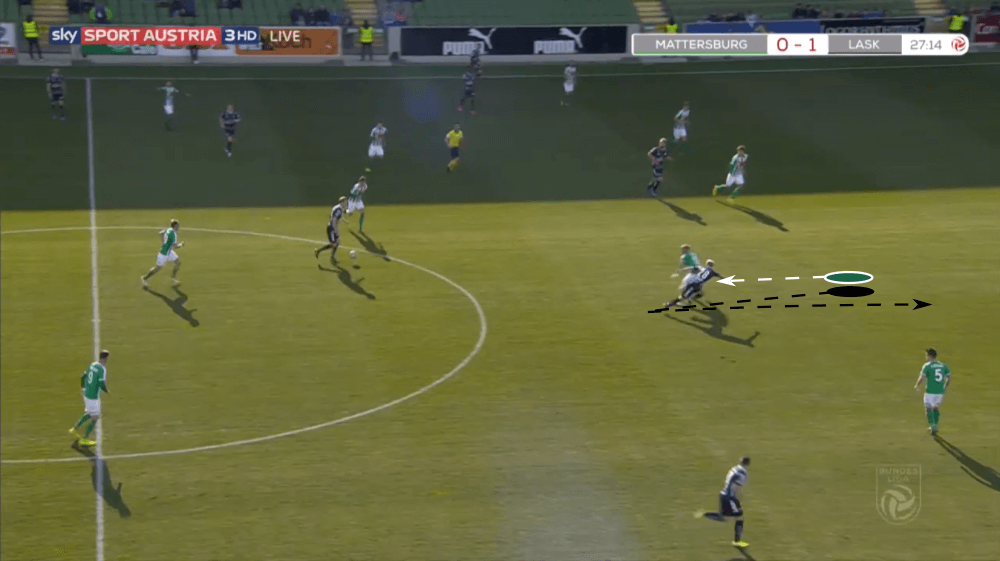
However, sometimes this man-orientation can lead to a huge empty space. Additionally, whenever the central midfielders also follow their opponents (what they don’t always do while the defenders mainly stick with this tactic) a huge free area occurs in the centre. Furthermore, we can often see a lack of communication between the players what then leads to situations like the one below in which the defender and central midfielder follow one player and none of them tracks the run of the other opponent who drives into the centre.
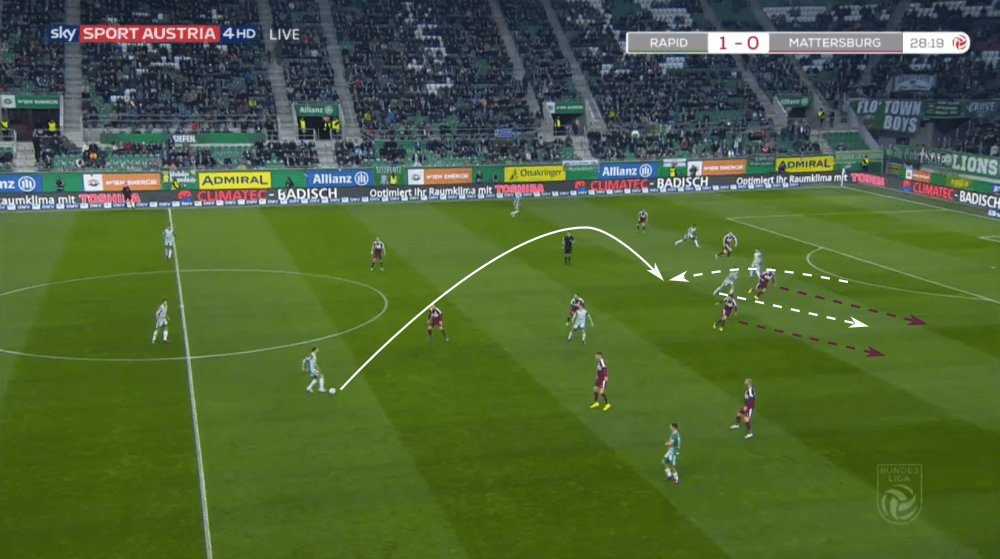
Conclusion
We can clearly see that the switch to the back thee helped Mattersburg massively even though the results are still not that outstanding. It’s nice to see a team which isn’t that successful continuing to use a high pressing and a counter-pressing and stay brave.
One of their greatest problems is that the man-orientation often leads to huge free spaces. Communication will be especially in these moments extremely important to solve these problems. Also, they need to work on their organisation in the centre and when the ball gets played into the wide-areas





Comments